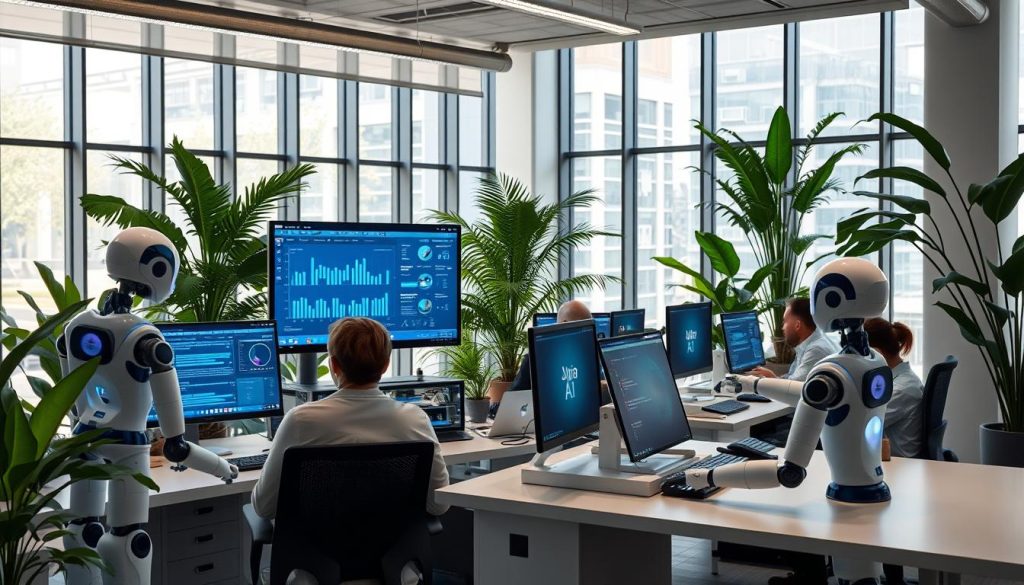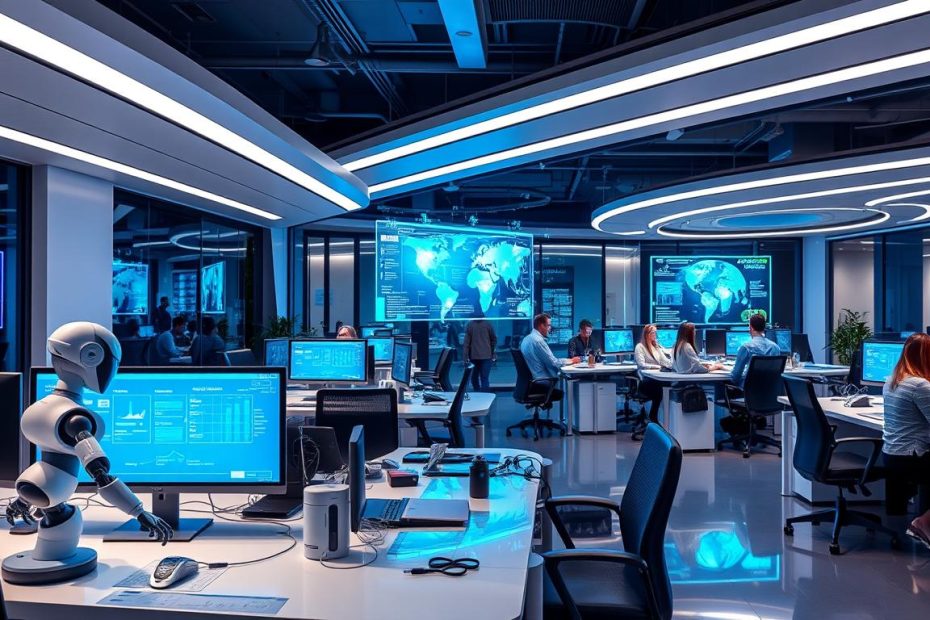I’ve seen how artificial intelligence changes office work. It’s made a big difference in how we work. Offices can now do things faster and better with AI.
AI helps offices work smarter, not harder. It cuts down on the work we do by hand. This lets employees do more important and creative tasks.
Exploring AI in offices is exciting. I’m sharing how AI is changing office work. From making offices run smoother to helping us work better, AI is making a big impact.
AI has a lot of power to make offices better. I’m looking into how AI, office automation, and productivity tools are changing work. With AI, offices can handle the easy tasks. This lets employees do more important work that helps the business grow and innovate.
The Dawn of AI in Modern Offices: My First-Hand Experience
I once doubted AI’s role in offices. But seeing how machine learning and natural language processing changed our work, I now believe in its power. AI tools have transformed our work, automating tasks and giving us more time for strategy.
Virtual assistants have become key to better communication and teamwork. They use natural language processing to streamline our work and boost productivity. For example, they help schedule meetings and support customers. This has cut our team’s workload and made our operations more efficient.
From Skeptic to Believer: My Journey with AI Tools
My AI journey started with a small project to test its use in our office. We began with simple tasks like data entry and document processing. The results were great, leading us to tackle more complex tasks like predictive analytics and natural language processing.
Key Changes I’ve Witnessed in Daily Operations
Several changes have marked our daily work:
- Improved productivity and efficiency
- Enhanced communication and collaboration
- Increased accuracy and reduced errors
- Better decision-making with predictive analytics

The New Office Dynamic with AI Integration
AI has changed our office, making it more efficient and productive. Employees now focus on strategic tasks, not just routine work. With AI, we’re excited to see how it will further transform our office and the industry.
How AI is Revolutionizing Office Work Through Automation
Office automation is changing how we work, making tasks easier and less work. AI tools help automate tasks like data entry and document management. This saves time and boosts accuracy and efficiency.
Machine learning is key in making office work better. It helps offices analyze data, spot patterns, and make smart choices. This leads to better productivity and performance.
- Automated data entry and processing
- Intelligent document management systems
- Predictive analytics for informed decision-making
Reports show that automation and productivity tools are getting more popular in offices. By using office automation and machine learning, businesses can stay ahead and reach their goals faster.
Exploring office automation’s benefits is exciting. With the right tools and algorithms, the future of work looks bright.
Smart Document Management and Processing
Exploring office automation, I see how vital smart document management is. AI tools can sort, extract, and analyze documents on their own. This cuts down on manual work, saving time and boosting productivity.
Reports on document management and AI stress the need for smart filing systems. These systems help offices manage documents better, making it simpler to find and share information. By using AI for data extraction and document management, businesses can run smoother and make smarter choices.
Benefits of AI-Powered Document Management
- Automated document classification and categorization
- Efficient data extraction and analysis
- Intelligent filing systems for easy information retrieval
Adopting smart document management and processing can greatly reduce errors and boost efficiency. In my office, AI tools have made us more productive and helped us use our time better.
Implementing Intelligent Filing Systems
To set up intelligent filing systems, start by reviewing your current document management. Use AI tools and data extraction to make your system more efficient and organized.
| Document Management Process | Traditional Method | AI-Powered Method |
|---|---|---|
| Document Classification | Manual classification | Automated classification using AI |
| Data Extraction | Manual data entry | Automated data extraction using AI |
| Document Retrieval | Manual search | Efficient retrieval using intelligent filing systems |
Virtual Assistants and Meeting Management
Exploring the role of virtual assistants in meeting management shows their big impact. They help make office work smoother. AI-powered virtual assistants automate tasks like scheduling, note-taking, and reminders. This lets employees stay organized and focused.
Using virtual assistants for meeting management brings many benefits. Here are some:
- Improved scheduling: Virtual assistants can schedule meetings and send reminders, cutting down on missed meetings.
- Enhanced collaboration: They help by sharing meeting notes and action items with everyone involved.
- Increased productivity: By handling routine tasks, virtual assistants let employees focus on more critical work, boosting productivity.
Virtual assistants also work well with collaboration tools to improve meeting management. For instance, they can:
send out meeting invites,
assign tasks, and
share meeting notes with everyone.
By using virtual assistants and collaboration tools, offices can make their meeting management better. This leads to better results and more success.
AI-Enhanced Communication and Collaboration Tools
Exploring AI’s impact on office work, I’ve seen how important AI-enhanced tools are. These tools change how teams work together, making communication and collaboration smooth. Now, teams can work together, no matter where they are.
These platforms offer real-time translation, breaking down language barriers. This is a big win for global teams, helping them work better together. AI also makes project management easier, with tools to assign tasks and track progress.
- Improved communication across teams
- Enhanced collaboration and productivity
- Real-time translation and transcription capabilities
- Streamlined workflows and project management
Using these tools, offices can work better and achieve more. I’ve seen how AI tools can change work for the better, making it more efficient and fun.
Predictive Analytics in Business Decision Making
Predictive analytics is key in business decision making. It helps offices analyze big data, spot patterns, and predict future trends. AI tools make this easier, helping businesses forecast sales and find ways to improve.
Some big benefits of using predictive analytics include:
- Improved forecasting accuracy
- Enhanced risk management
- Increased operational efficiency
- Better customer insights
Reports say predictive analytics can boost revenue by up to 10% and cut costs by up to 5%. It gives businesses a competitive edge and helps them make smart, data-driven choices.
Predictive analytics uses data analysis and machine learning to find patterns. It helps businesses uncover new insights and opportunities. This makes predictive analytics a must-have for staying ahead and making informed decisions.
| Benefits of Predictive Analytics | Description |
|---|---|
| Improved Forecasting | Enable businesses to make accurate predictions about future trends and outcomes |
| Enhanced Risk Management | Help businesses identify and mitigate possible risks and threats |
| Increased Operational Efficiency | Streamline business operations and improve overall efficiency |
The Human-AI Partnership in Modern Workplaces
AI is becoming more common in offices. It’s key to keep the personal touch and work well with AI. A good partnership between humans and AI is vital for getting the most out of AI technology.
Reports show that communication and understanding are key in human-AI partnerships. To work well with AI, we need skills for effective interaction. This means knowing what AI can and can’t do, and how to talk to it.
Maintaining the Personal Touch
Keeping the personal touch is important in human-AI partnerships. We should use AI to enhance human skills like empathy and creativity. This way, work can be more personalized and focused on people.
Building Effective AI Collaboration Skills
To work well with AI, we need to understand AI technology. We should know where AI can help and how to talk to it. Key skills include:
- Knowing what AI can and can’t do
- Learning how to communicate with AI
- Using human skills like empathy and creativity
By improving these skills and keeping the personal touch, we can make work better. A human-AI partnership can make processes smoother, improve decisions, and spark new ideas. As work changes, focusing on collaboration skills and human-AI partnerships is essential.
Addressing Privacy and Security Concerns
Exploring AI-powered tools shows how vital privacy and security are. Offices must protect sensitive data and keep employee and customer privacy safe. This is more important than ever with AI’s growing use.
Here are some ways to tackle these issues:
- Implementing robust security measures, such as encryption and access controls
- Educating employees about data protection best practices
- Conducting regular security audits to identify and fix vulnerabilities
Data protection is a major focus for businesses, reports show. Effective security steps can lessen privacy worries. Offices can use AI responsibly and securely by addressing these concerns early on.
Training and Adaptation Strategies
AI is becoming more common in the workplace. It’s key to develop training strategies for employees to adapt to new tech. This means creating plans that focus on skills like data analysis, critical thinking, and creativity.
Reports show that training is vital for a smooth transition to AI workplaces. By giving employees the right skills and support, businesses can fully use AI. This helps them stay competitive.
Building Essential Skills
To make good training strategies, we need to know the key skills for AI workplaces. These include:
- Data analysis and interpretation
- Critical thinking and problem-solving
- Creativity and innovation
- Communication and collaboration
Creating Balanced Implementation Plans
A good plan should mix training, support, and trying new things. This can be done by:
| Strategy | Description |
|---|---|
| Training Sessions | Regular training to build essential skills |
| Experimentation | Encouraging employees to try new tech and methods |
| Support | Providing ongoing help and resources for adapting to new tech |
Preparing Your Office for Tomorrow’s AI Innovation
AI is changing fast, and we must keep up. Investing in AI research is key for office readiness. This helps us innovate and stay ahead.
Here are some ways to get ready for AI in your office:
- Keep up with the latest AI trends and innovations.
- Use AI tools to make work easier and more efficient.
- Encourage a culture where trying new things is okay.
By embracing AI, we open doors to new success. It’s vital to think about AI’s role in our work. We need strategies that match our business goals.
AI will change work a lot, reports say. Many jobs will be automated or improved by AI. But, this also means new jobs and skills, like in AI research and data science.
To be ready for AI’s future, we must be proactive. Invest in AI research, stay current with trends, and foster innovation. This way, we can grow and succeed in a fast-changing world.
Embracing the AI Revolution: Your Next Steps Forward
The AI revolution is changing the modern office. It brings us new tools to boost productivity, communication, and decision-making. Embracing this change can open up new possibilities for a better workplace.
Start looking into AI solutions that fit your office’s needs. Check out the latest in virtual assistants, document management, predictive analytics, and collaboration tools. Try them out, get your team’s feedback, and slowly add them to your work routine. Keep the personal touch to maintain a positive work culture.
With the right approach, AI can lead your office to success and happiness. It can make tasks easier, improve decision-making, and give you more time for creative work. The future of work is now, and it’s time to make it your own.
